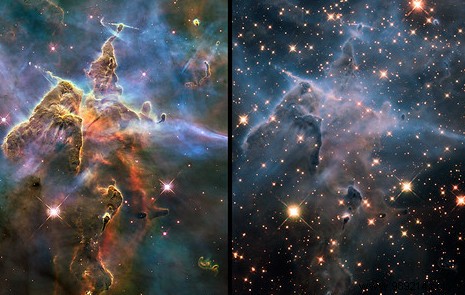Once launched, the James Webb Telescope will be the most powerful space observatory in history. But how will his photos be compared to those of Hubble, a true reference in the matter?
One has greatly expanded our view of the cosmos and captured our attention with its stunning imagery over the past three decades; the other plans to revolutionize our approach to the universe over the next three decades. The James Webb Telescope is indeed often described as the replacement or successor to Hubble. However, it is worth highlighting the differences between these two observatories which, for a time, may even complement each other.
For one thing, these two telescopes will be very far apart in space. As Hubble orbits in low Earth orbit, the JWT will position itself 1.5 million kilometers from Earth on the Lagrange point Sun-Earth 2 (L2). On the other hand, these two instruments will not "see" the universe in the same way. This is because while Hubble observes light at primarily optical and ultraviolet wavelengths (wavelength range of approximately 200 nanometers to 2.4 microns), the JWT is designed to primarily detect light infrared (about 600 nm at 28 microns).
“It will be very, very different from Hubble “, emphasizes Klaus Pontoppidan, of the Space Telescope Science Institute in Baltimore. "And I think it will be fantastic ".

Note that while the James Webb Telescope will primarily observe the infrared light, it will still be able to see the red/orange part of the visible light spectrum. The gold coating of its mirrors indeed absorbs blue light from the visible spectrum, but reflects the yellow and red visible light that will be detected.
Although this is not its main observing function, Hubble does however also have the ability to observe some infrared. In 2013, the telescope team released a stunning infrared image of the Horsehead Nebula to celebrate the 22nd anniversary of its launch.

Since the 90s, Hubble has regularly provided us with images of breathtaking clarity, revealing stars and galaxies like never before. The angular resolution of the JWT will be about the same. In other words, the images of the latter will appear as sharp as those of its "predecessor".
However, the JWT will offer a much larger mirror:6.5m wide, up from 2.4m. This will allow it to probe the universe deeper, revealing objects ten to a hundred times fainter than what Hubble can observe .
His infrared gaze will eventually be powerful enough to pierce the densest cosmic dust clouds, behind which lurk the first stars and galaxies formed after the Big Bang.